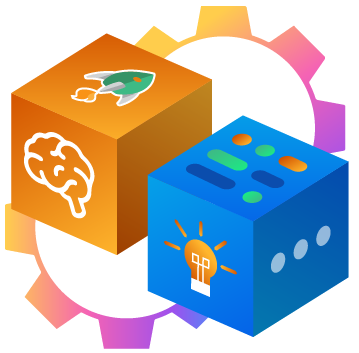
Understanding Feature Engineering
Feature engineering is a crucial step in the machine learning pipeline that involves transforming raw data into a suitable format for training machine learning models. It is the process of selecting, creating, and transforming features (input variables) that best represent the underlying patterns and relationships in the data. Let's consider a real-life example of predicting house prices. Suppose the requirement is to build a machine learning model that predicts the price of a house based on its features, such as the number of bedrooms, square footage, location, age, etc.
In feature engineering:
-
Select existing features: Include the number of bedrooms and square footage as they directly relate to a house's size and potential value.
-
Create new features: Create a new feature called "price per square foot" by dividing the price of the house by its square footage. This feature captures the house's value relative to its size and can provide additional insights into the model.
-
Transform features: Transforming the age of the house into a "years since last renovation" feature, which indicates how long ago the house was last renovated. This transformation can help the model capture the impact of recent renovations on the house price.
A rapidly growing field with significant potential for various industries and applications. Taken From Article, Real-Time Intelligence
By carefully selecting, creating, and transforming features, we can provide the machine learning model with more relevant and meaningful information to learn from. This can lead to better predictions and a more accurate understanding of the relationship between the features and the target variable (house price in this example).
In simple terms, feature engineering in machine learning involves:
-
Choosing useful features.
-
Creating new ones if needed.
Transforming them enhances the model's ability to make accurate predictions.
It helps the model capture essential patterns and relationships in the data, improving its performance and usefulness in real-life applications.
Understanding Real-Time ML
Real-time machine learning (ML) applies ML techniques in scenarios where predictions, decisions, or insights must be generated in real-time or near real-time, typically within a few milliseconds to seconds. Unlike batch processing, where data is processed in large batches offline, real-time ML systems process data as it arrives, enabling quick responses and timely actions. To understand real-time ML, it's essential to grasp the following concepts and challenges associated with it:
A continuously training a machine learning model with live data instead of relying on historical testing data in an offline mode. Taken From Article, Real-time Machine Learning
Batch vs. Real-Time ML: Key Differences
Batch processing and real-time ML differ in their approach to data processing:
| Aspect | Batch Processing | Real-Time ML |
| Data Arrival and Processing | Data is collected and processed in large batches offline | Real-time ML processes data as it arrives, providing immediate responses. |
| Timeliness | Batch processing is suitable for non-time-critical tasks | Real-time ML enables instant predictions or decisions that require quick responses. |
| Iterative Learning | Batch processing often involves training models on fixed datasets. | In real-time ML, models can be updated continuously as new data arrives, allowing for adaptive learning |
Challenges in Real-Time ML
- Low Latency Requirements: Real-time ML systems must deliver predictions or insights within strict time constraints, requiring efficient algorithms, optimized computations, and streamlined processing pipelines.
- Resource Constraints: Real-time ML often operates in resource-constrained environments like edge devices or real-time data streaming platforms. Models and feature engineering techniques must be tailored to work within these limitations.
- Concept Drift: Real-time ML systems may encounter concept drift, where the underlying data distribution or relationships change over time. Feature engineering and model adaptation techniques are needed to handle these dynamic environments.
- Data Quality and Noise: Streaming data can be noisy and contain outliers or missing values. Real-time ML systems must employ robust data pre-processing techniques to ensure data quality before feature engineering and modelling.
Understanding these concepts and challenges allows us to make informed decisions and design effective solutions when building real-time ML applications. By considering these factors, developing real-time ML systems that meet the specific requirements of an application will be more effective.
MLOps helps deploy ML models within minutes rather than weeks and enables them to achieve a far faster value result. Taken From Article, MLOps Platform - Productionizing ML Models
Feature Engineering: What’s the Goal?
The primary goal of feature engineering in machine learning is to enhance the performance and effectiveness of a machine learning model by providing it with informative, relevant, and discriminative input features. Feature engineering aims to improve the model's ability to understand the underlying patterns and relationships in the data, leading to more accurate predictions or insights. The critical goals of feature engineering in ML are:
- Improve Predictive Performance: Feature engineering helps uncover meaningful patterns and relationships in the data crucial for accurate predictions. By selecting or creating informative features, feature engineering enables the model to capture the relevant information necessary to make accurate predictions.
- Enhance Model Understanding: Well-engineered features can simplify and represent complex data more understandably. By transforming and encoding the data appropriately, feature engineering can better represent the underlying relationships, making it easier for the model to learn and generalize from the data.
- Handle Nonlinearity and Complex Relationships: In many real-world scenarios, the relationships between features and the target variable are often nonlinear or complex. Feature engineering allows new features or transformations to better capture these complex relationships, enabling the model to learn and predict more accurately.
- Handle Missing or Incomplete Data: Feature engineering techniques can address missing values or incomplete data by applying appropriate imputation methods or creating additional features that capture the missing patterns. This ensures the model can handle real-world scenarios where data may be incomplete or contain missing values.
- Improve Model Efficiency and Scalability: Feature engineering can improve machine learning models' efficiency and scalability. By reducing the dimensionality of the feature space or selecting relevant features, feature engineering can speed up model training and inference, making it more feasible to apply ML techniques to large-scale or real-time applications.
The ultimate goal of feature engineering in ML is to provide the model with a rich set of informative features that capture the relevant aspects of the data, leading to improved predictive performance, better model understanding, and enhanced generalization capabilities.
Real-time analytics tools are software applications that enable organizations to collect, process, and analyze data in real-time or near-real time. Taken From Article, Real-time Analytics Tools
Importance of Feature Engineering in Real-time ML
Feature engineering plays a vital role in real-time machine learning, where data is generated and processed in real-time or near real-time. In real-time ML applications, such as fraud detection, predictive maintenance, or recommendation systems, timely and accurate predictions are essential. Therefore, feature engineering becomes even more critical as it directly impacts real-time predictions' speed, accuracy, and reliability. Below are some key reasons why feature engineering is crucial in real-time ML:
- Data Quality and Noise Handling: Streaming data may contain noise, outliers, or missing values, which can impact the performance of real-time ML models. Feature engineering involves robust data pre-processing techniques to handle these challenges effectively. By addressing missing data, outlier detection, or data cleaning, feature engineering helps improve data quality and reliability, leading to more accurate predictions in real-time ML systems.
- Improved Prediction Accuracy: Quality data and well-engineered features help the model understand the underlying data dynamics and improve prediction accuracy in real-time scenarios.
- Reduced Latency and Faster Response: Real-time ML systems require quick response times to provide timely predictions or decisions. Well-designed features that can be computed in real-time help reduce latency and enable faster response times, ensuring timely predictions and actions.
- Adaptation to Changing Data Patterns: Real-time ML systems often operate in dynamic environments where data distributions, relationships, or concepts may change over time. Feature engineering enables the system to adapt by incorporating adaptive feature selection or engineering techniques. This flexibility ensures the selected features remain relevant and practical, capturing the evolving data patterns and maintaining model performance as the data streams evolve.
This is how feature engineering plays a critical role in real-time ML by improving prediction accuracy, reducing latency, adapting to changing data patterns, optimizing resource efficiency, and handling data quality challenges. By investing time and effort in practical feature engineering, organizations can build robust and efficient real-time ML systems that provide accurate and timely predictions or decisions, enabling them to make informed choices and take immediate actions based on streaming data.
Top Feature Extraction Techniques
Some standard feature extraction techniques used in real-time ML:
- One Hot Encoding: One Hot Encoding represents categorical variables as binary vectors. Each category becomes a binary feature, with 1 indicating its presence and 0 for absence. This technique is proper when dealing with categorical data that ML models cannot directly use.
- Bag of Words (BOW): BOW is a technique for representing text data as a numerical feature vector. It counts the occurrence of words in a document or a collection of documents. Each word becomes a feature, and the count represents its importance. BOW is commonly used in text classification or sentiment analysis tasks.
- N-grams: n-grams are sequences of n consecutive words or characters in a text. They capture the context or dependencies between words in natural language processing tasks. By considering word sequences, n-grams can provide additional information and improve the understanding of the data. They may be used to extract functions from textual content records that may be utilized in device mastering fashions to enhance the overall performance of NLP tasks.
- Tf-Idf: Term Frequency-Inverse Document Frequency (Tf-Idf) is a technique that combines term frequency and inverse document frequency to weigh the importance of words in a text corpus. It helps highlight words that are more informative or distinctive across documents. Tf-Idf is often used in information retrieval, text mining, and text classification tasks.
- Custom Features: Custom features refer to engineered features created based on domain knowledge or specific insights about the problem. These features can be derived from existing features, combining multiple features, or transforming the data meaningfully. Custom features help capture relevant information or relationships not directly represented in the raw data.
- Word2Vec (Word Embedding): Word2Vec is a popular word embedding technique that represents words as dense vectors in a high-dimensional space. It captures semantic relationships between words and allows ML models to learn from and understand their meaning. Word2Vec is widely used in natural language processing tasks, such as text classification, translation, and sentiment analysis.
A collection of practices for communication and collaboration between operations professionals and data scientists. Taken From Article, MLOps Services Tools and Comparison
Best Practices for Real-Time ML Feature Engineering
When performing feature engineering for real-time machine learning (ML), it is essential to consider certain best practices to ensure the effectiveness and efficiency of the feature engineering process. Some recommended best practices are:
- Understand the Problem Domain: Gain a deep understanding of the problem domain, including the data sources, the target variable, and the business objectives. This understanding will guide the selection and creation of relevant and meaningful features for real-time predictions or decisions.
- Feature Relevance and Importance: Analyze the relevance and importance of each feature to the target variable. Consider performing statistical, feature importance ranking, or correlation analyses to identify the most informative features. Focusing on relevant features helps reduce noise and improve prediction accuracy.
- Handle Missing Data: Develop strategies to handle missing data appropriately. Depending on the scenario, you can remove samples or features with missing data, apply imputation techniques (e.g., mean imputation, interpolation), or create new features to capture the missingness patterns. Handling missing data ensures the robustness and reliability of the real-time ML system.
- Normalize or Scale Features: Normalize or scale features with similar ranges or distributions. Techniques like min-max scaling, z-score normalization, or robust scaling can help prevent features with larger magnitudes from dominating the ML model's learning process. Normalization enhances the model's performance and stability.
- Feature Selection and Dimensionality Reduction: Consider reducing the dimensionality of feature space by selecting a subset of relevant features. Techniques like univariate feature selection, recursive feature elimination, or feature importance analysis can assist in identifying the essential features. Additionally, dimensionality reduction techniques (e.g., PCA, t-SNE) can be applied to reduce the number of features while preserving the most critical information.
- Consider Real-Time Constraints: Remember the feature engineering process's computational efficiency and scalability. Ensure that the feature extraction or transformation techniques can be computed efficiently on streaming data, considering the ML system's real-time constraints. Use techniques like incremental feature extraction or feature caching to optimize processing time.
These best practices will help develop robust and efficient feature engineering strategies for real-time ML. Remember that feature engineering is an iterative process, and continuous monitoring and adaptation are essential to maintaining the features' performance and relevance in real-time scenarios.
Streaming Data Visualization gives users Real-Time Data Analytics to see the trends and patterns in the data to take action rapidly. Taken From Article, Real-Time Streaming Data Visualization
Future Trends in Feature Engineering
Feature engineering in real-time ML continues to evolve with emerging trends and directions in the field. Below are some future trends to consider:
- Automated Feature Engineering: As data complexity and scale increase, there is a growing need for automated feature engineering techniques. Automated feature engineering tools and frameworks leverage machine learning algorithms to automatically generate, select, and optimize features based on the given data. These tools can significantly reduce the manual effort required for feature engineering and enable faster model development.
- Domain-Specific Feature Engineering: Feature engineering techniques tailored to specific domains will continue to emerge. Different domains often have unique characteristics and requirements. Domain-specific feature engineering identifies domain-specific patterns, structures, or relationships that can be leveraged to improve model performance. Examples include healthcare-specific features for patient monitoring or financial-specific features for fraud detection.
- Unsupervised Feature Learning: Unsupervised learning techniques like clustering or autoencoders can be employed to learn informative representations from unlabelled data. These learned representations can be used as features in real-time ML systems. Unsupervised feature learning can capture latent structures or similarities in the data that may not be readily discernible through manual feature engineering.
- Streaming Feature Engineering: Traditional feature engineering assumes static datasets, but in real-time ML, data arrives continuously in streams. Future directions involve adapting feature engineering techniques to streaming data settings. This includes designing feature extraction methods to process data in real time, handle data drift, and update features dynamically as new observations arrive.
- Feature Importance and Explanation: Understanding the importance and impact of features on model predictions is crucial for transparency and interpretability. Future feature engineering approaches will likely focus on developing techniques to assess feature importance in real-time ML models. Additionally, feature engineering techniques may incorporate explainability methods to provide insights into how features contribute to model decisions.
Feature engineering will remain critical for effective and efficient model development as real-time ML applications evolve. These future trends and directions aim to enhance the automation, adaptability, interpretability, and performance of feature engineering in real-time ML systems.

- Explore here about Machine learning Model Validation Testing
- Read about the Continuous Delivery of Machine Learning Pipelines
Next Steps for Real-Time Machine Learning
Talk to our experts about implementing real-time machine learning systems. Learn how industries use real-time ML to optimize operations and improve decision-making, leveraging AI for efficiency and responsiveness.


